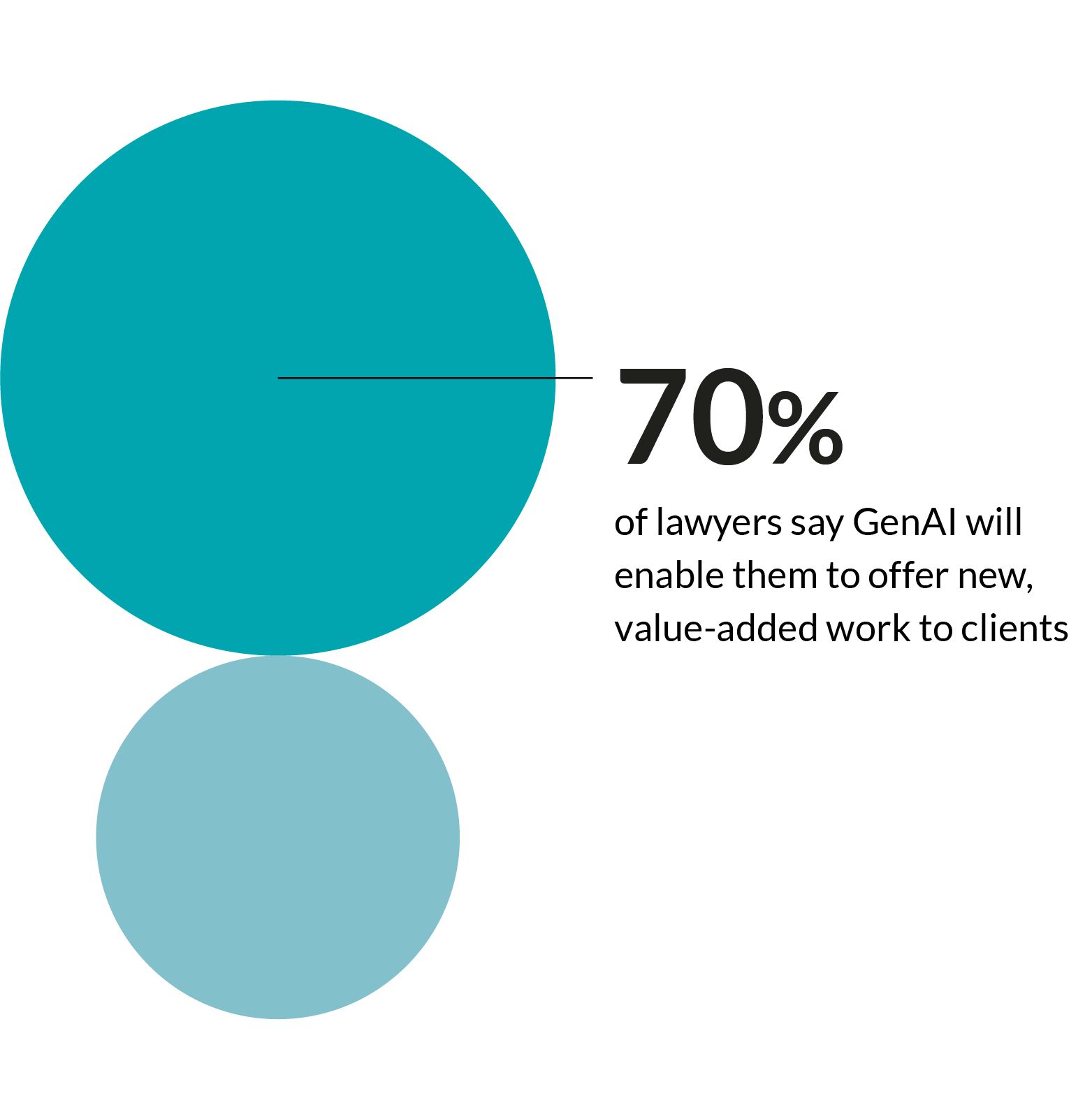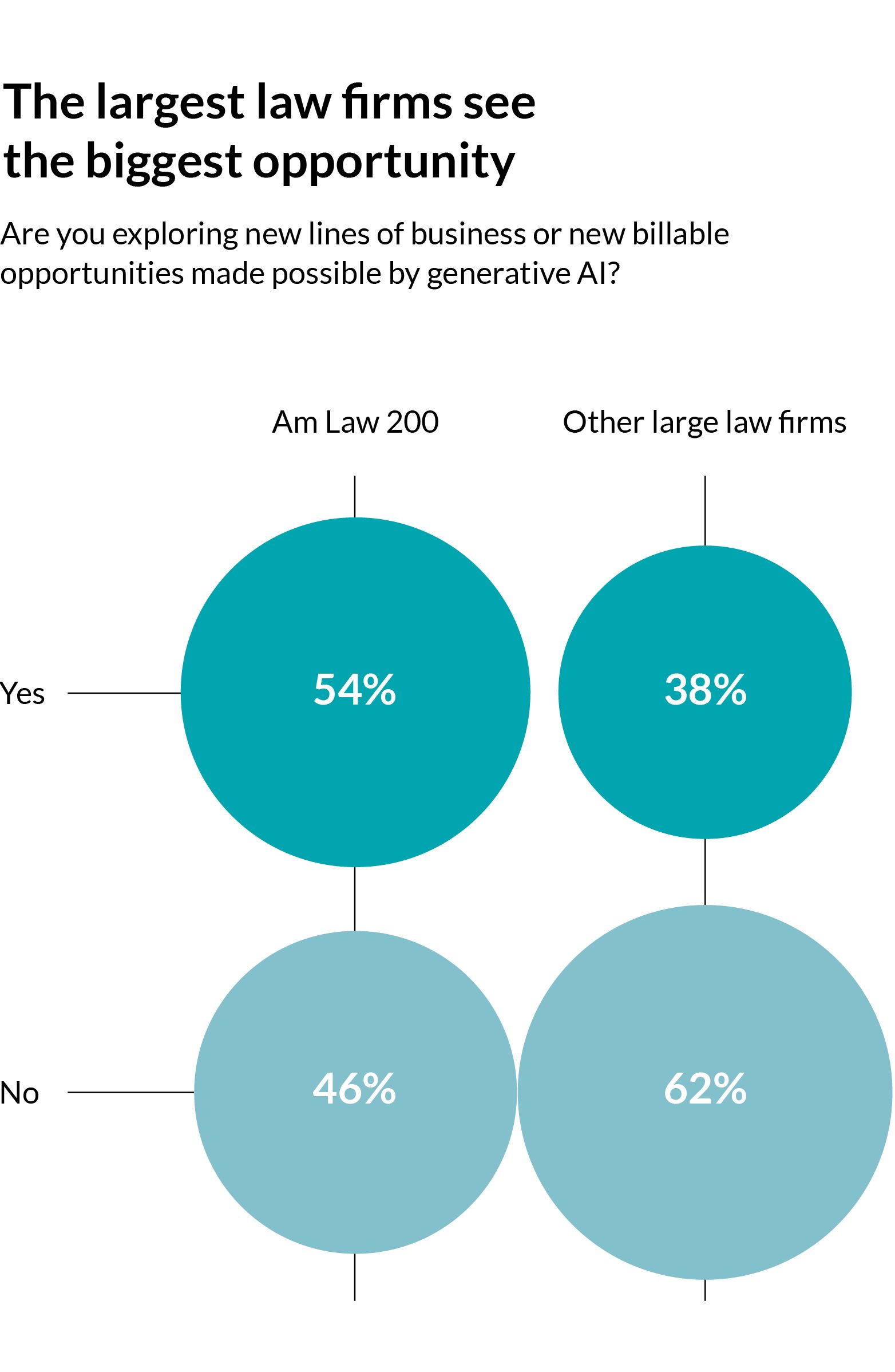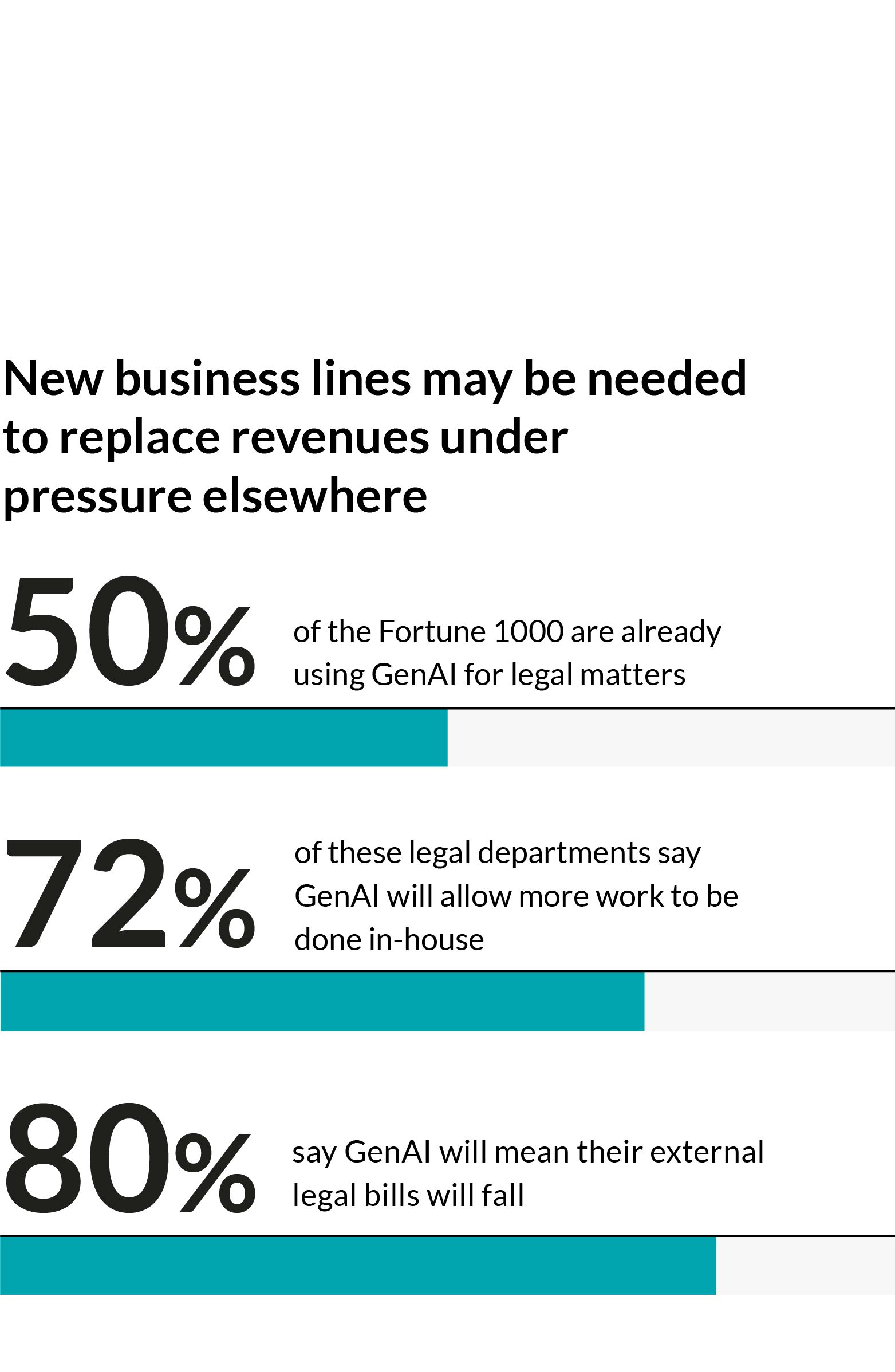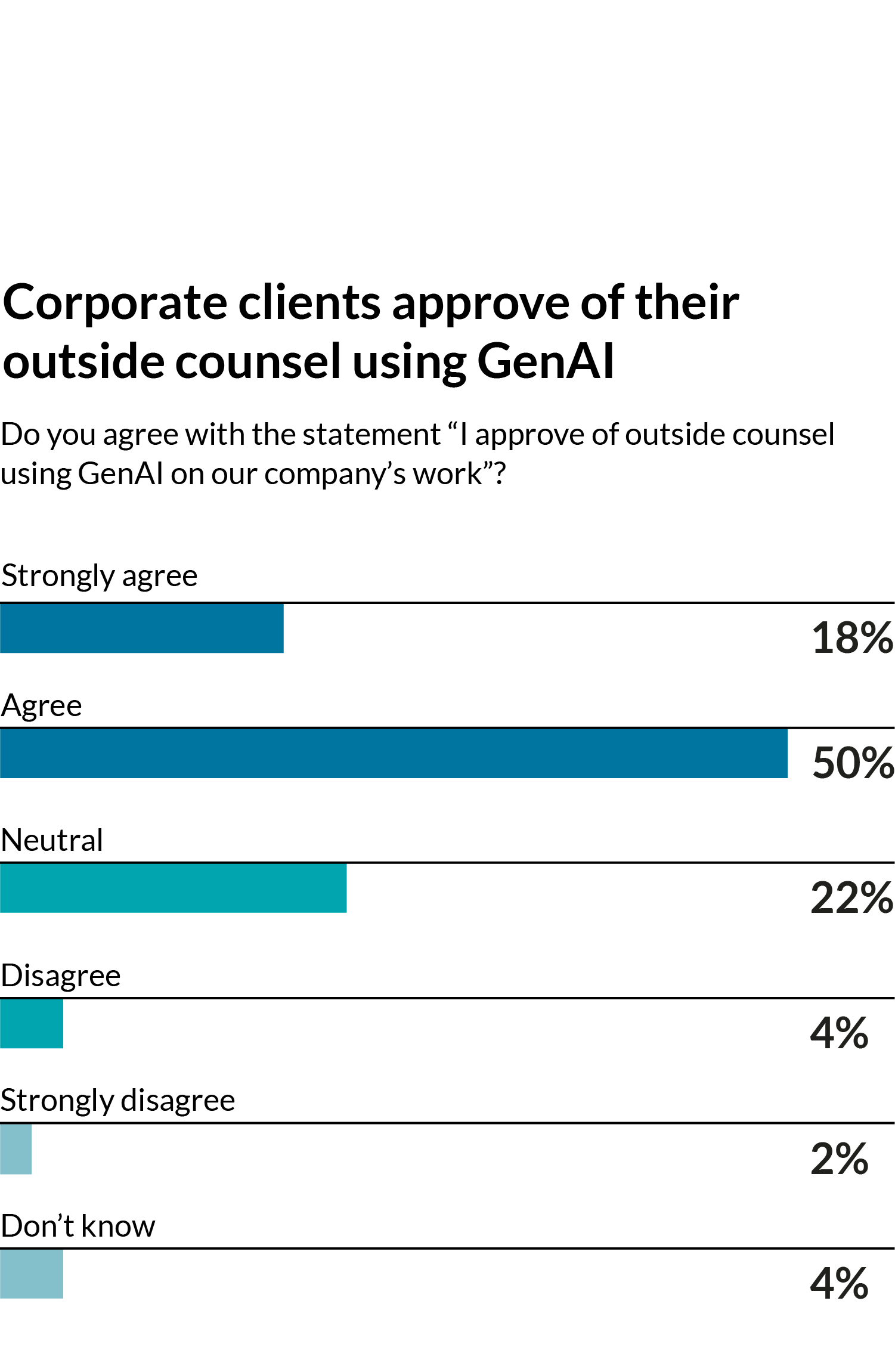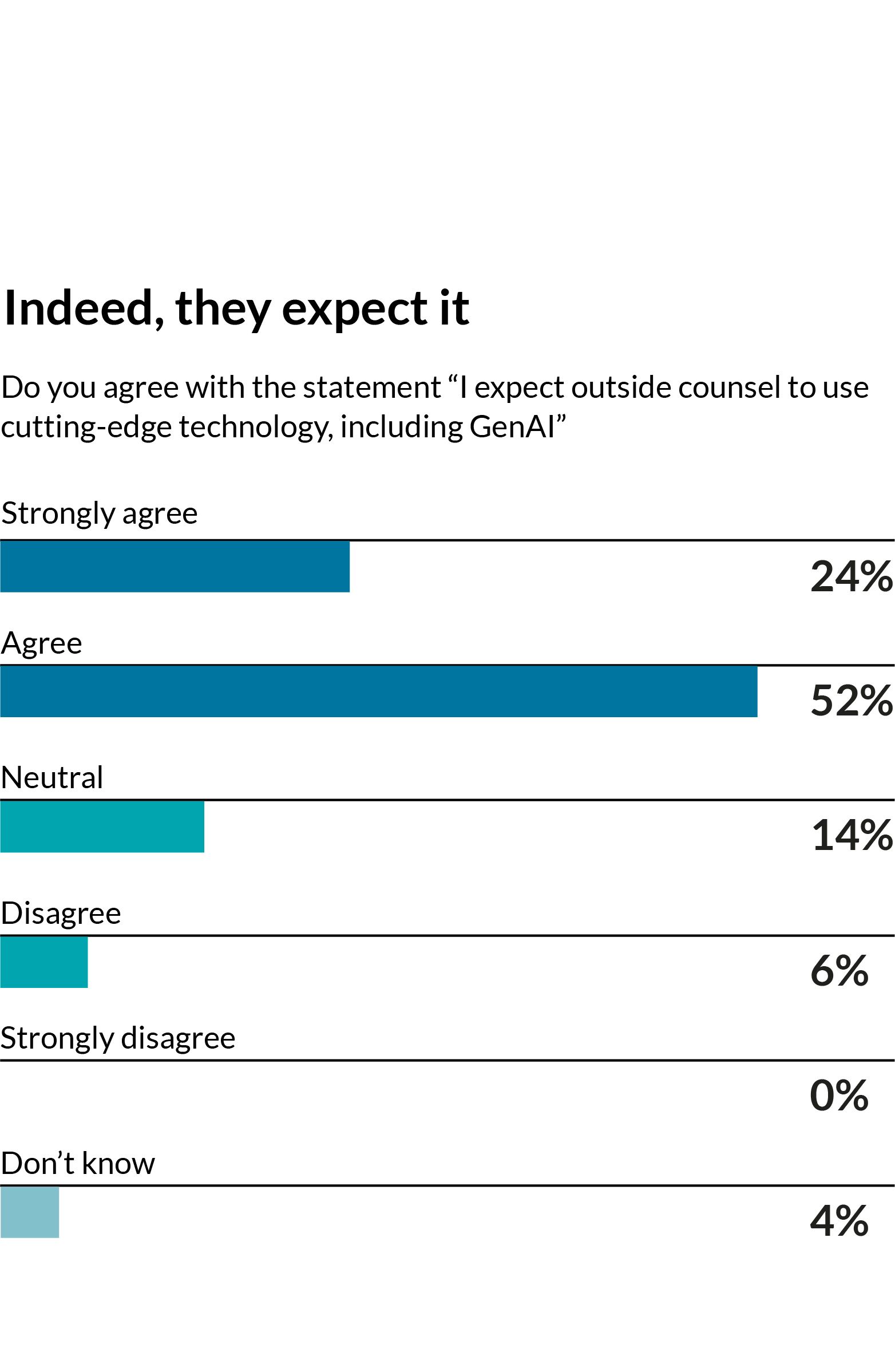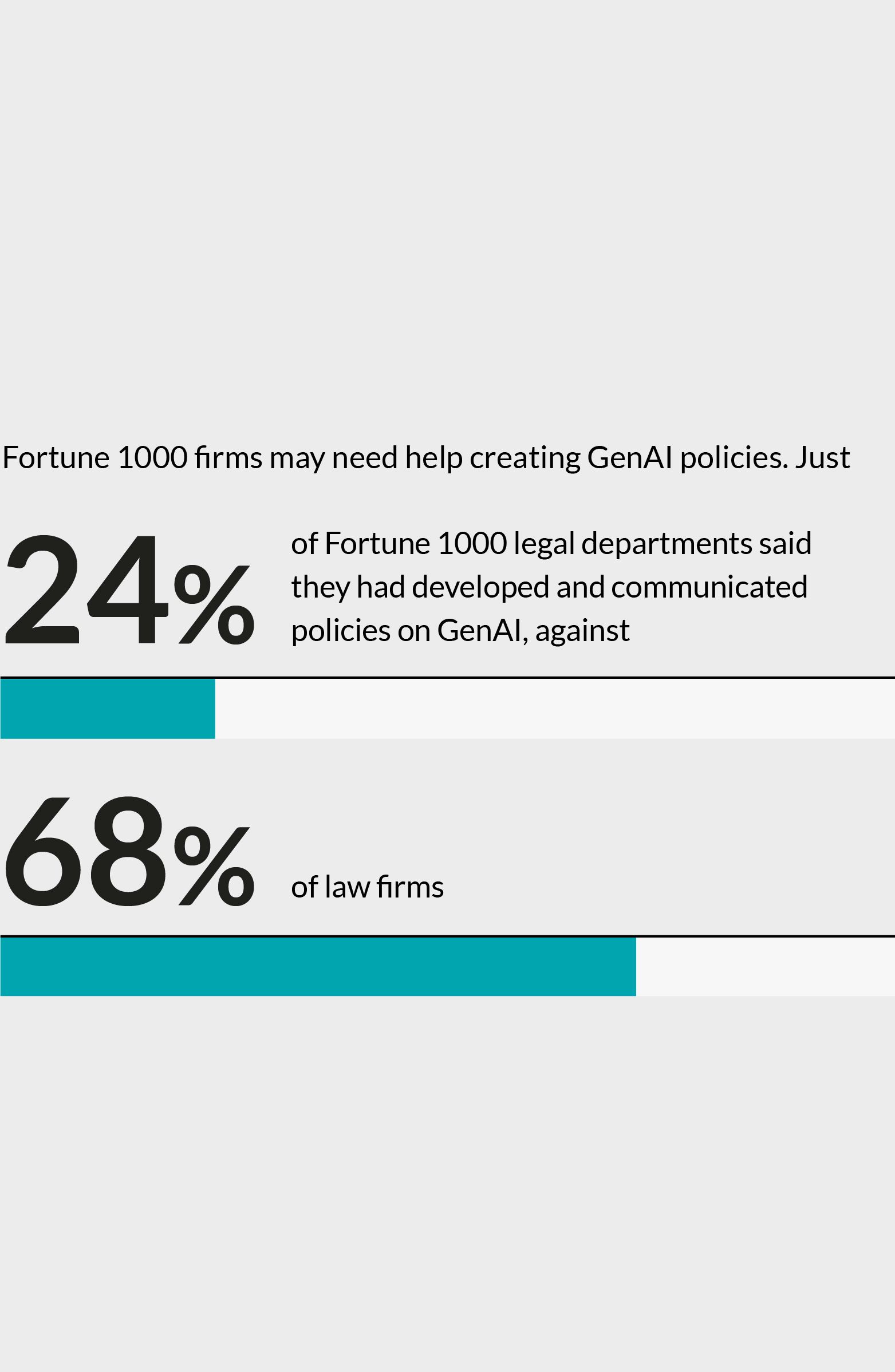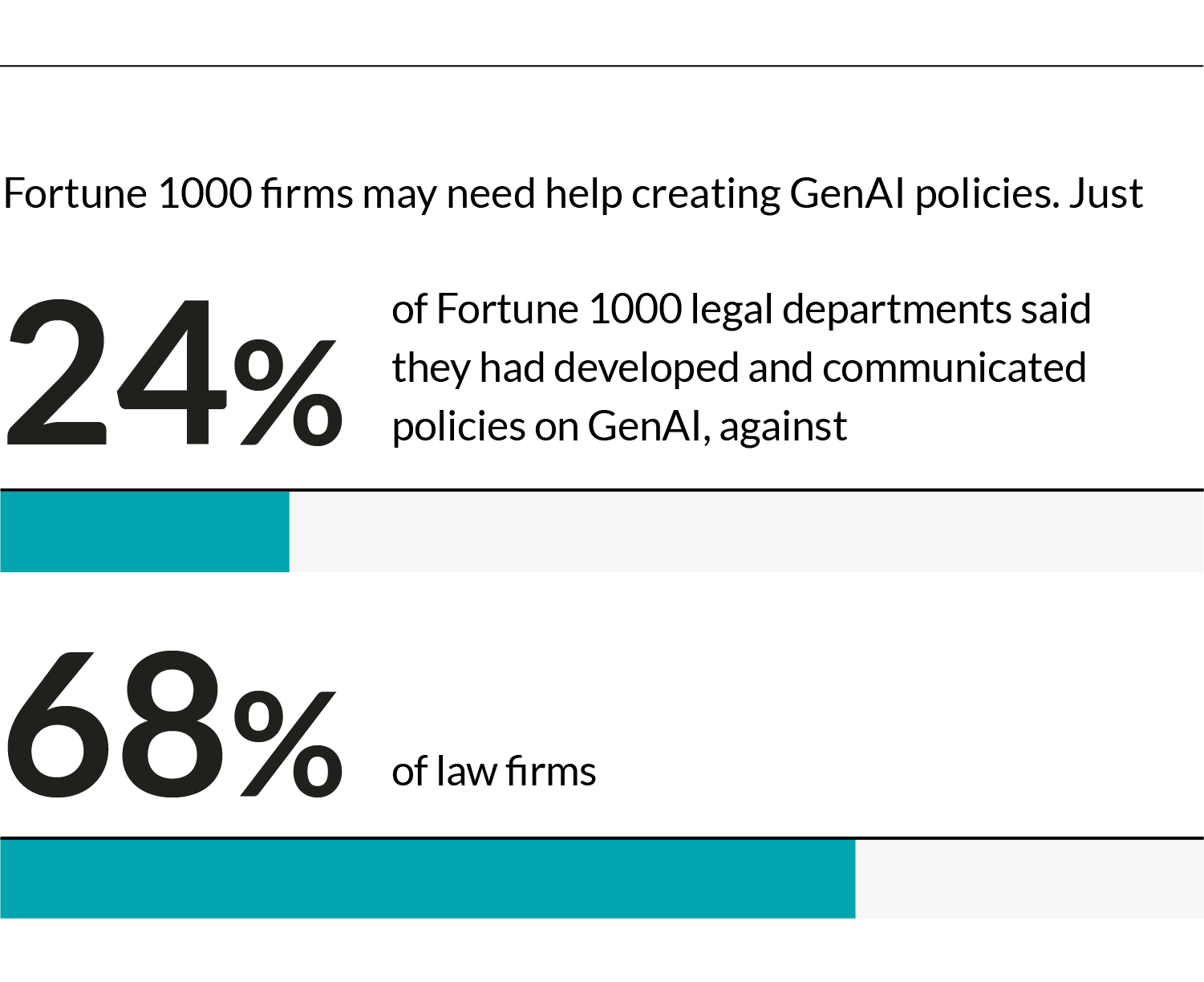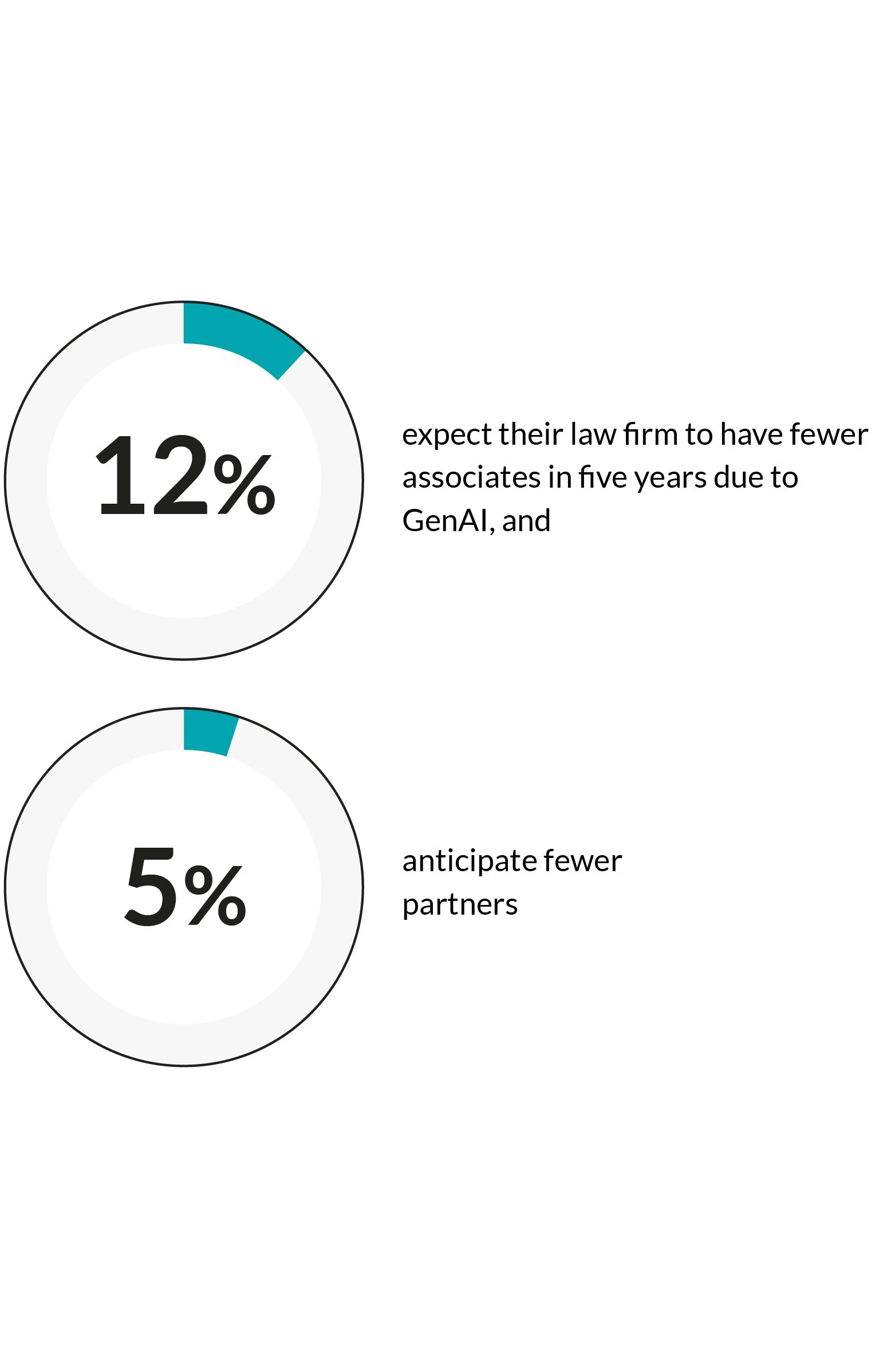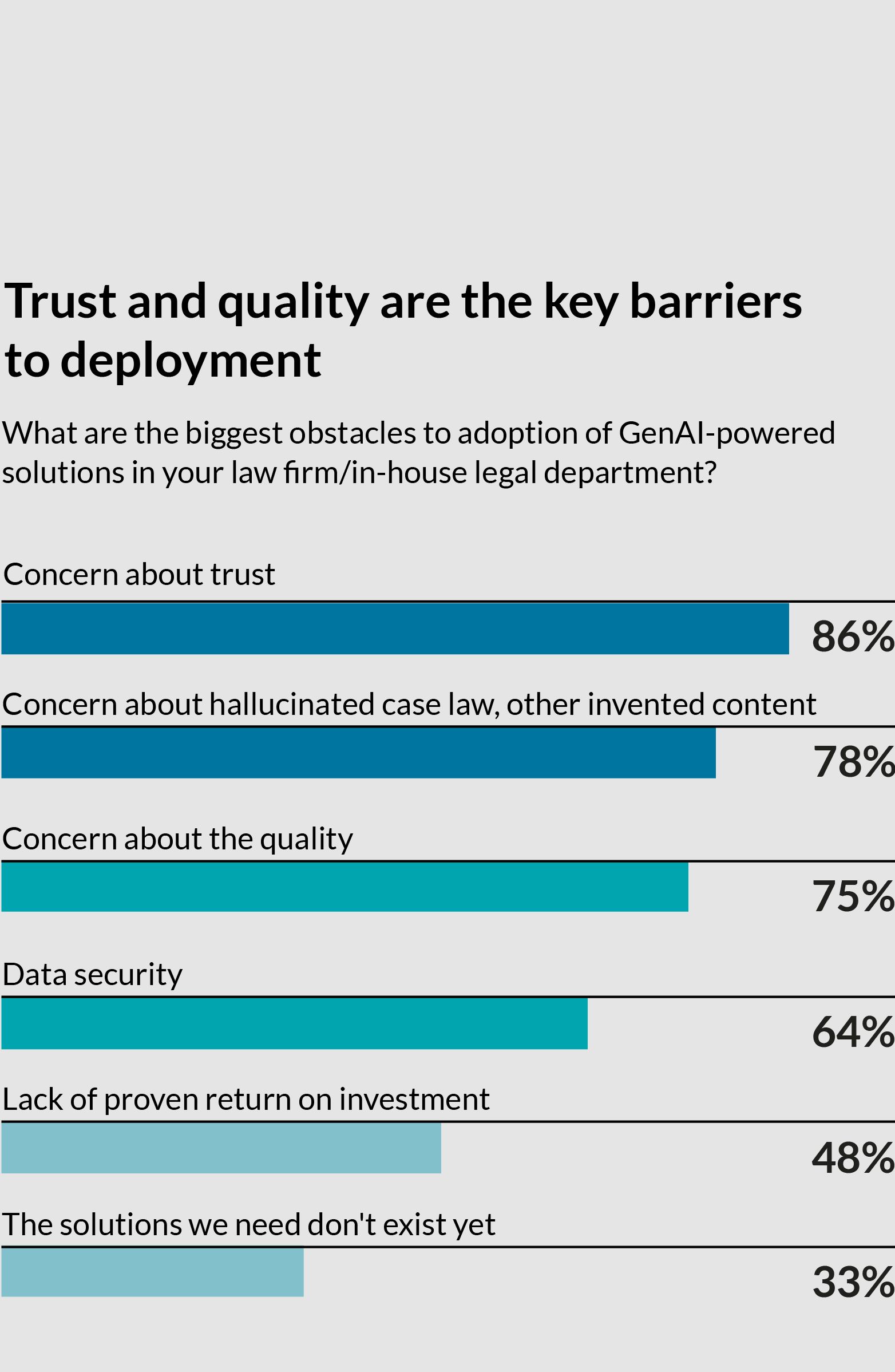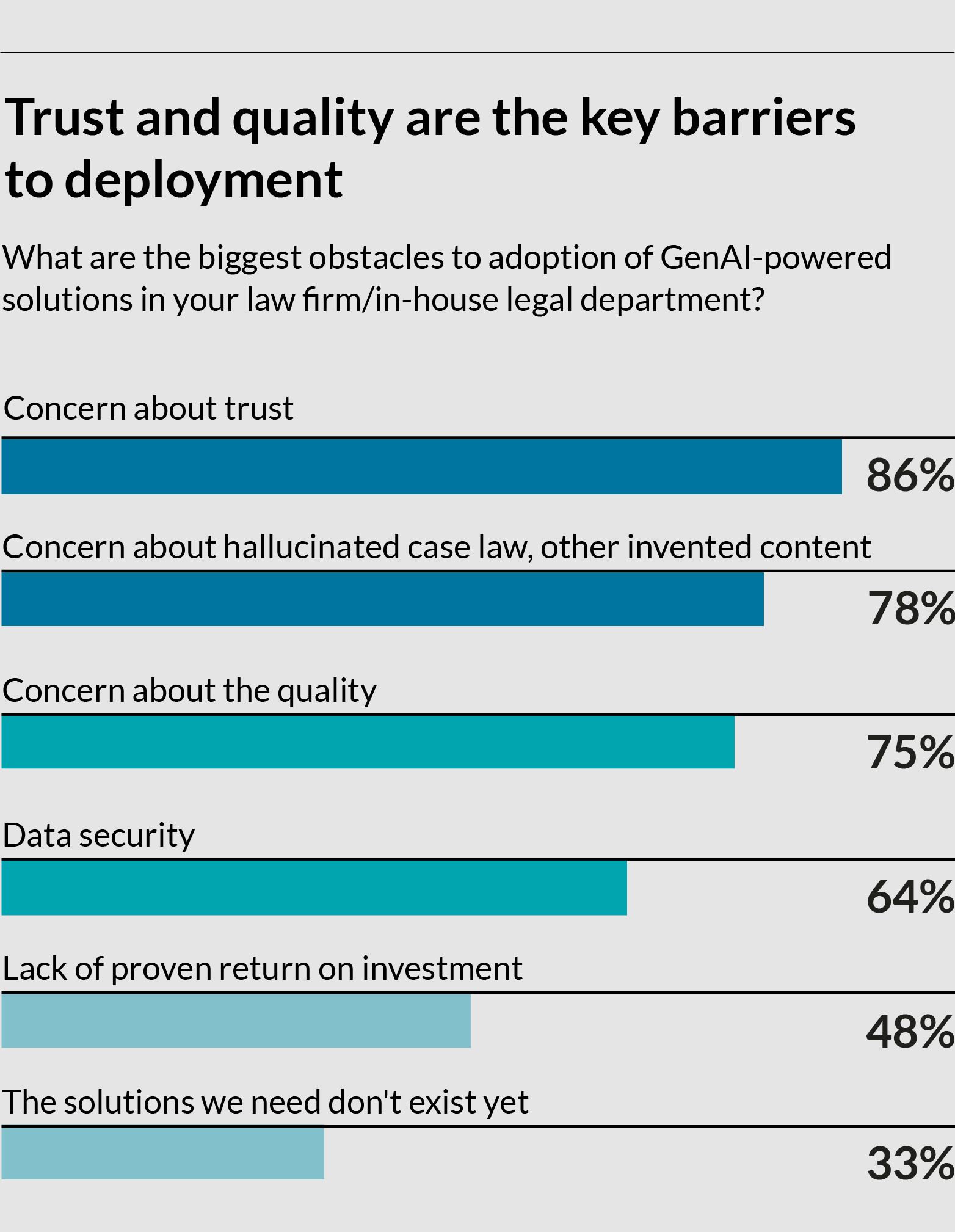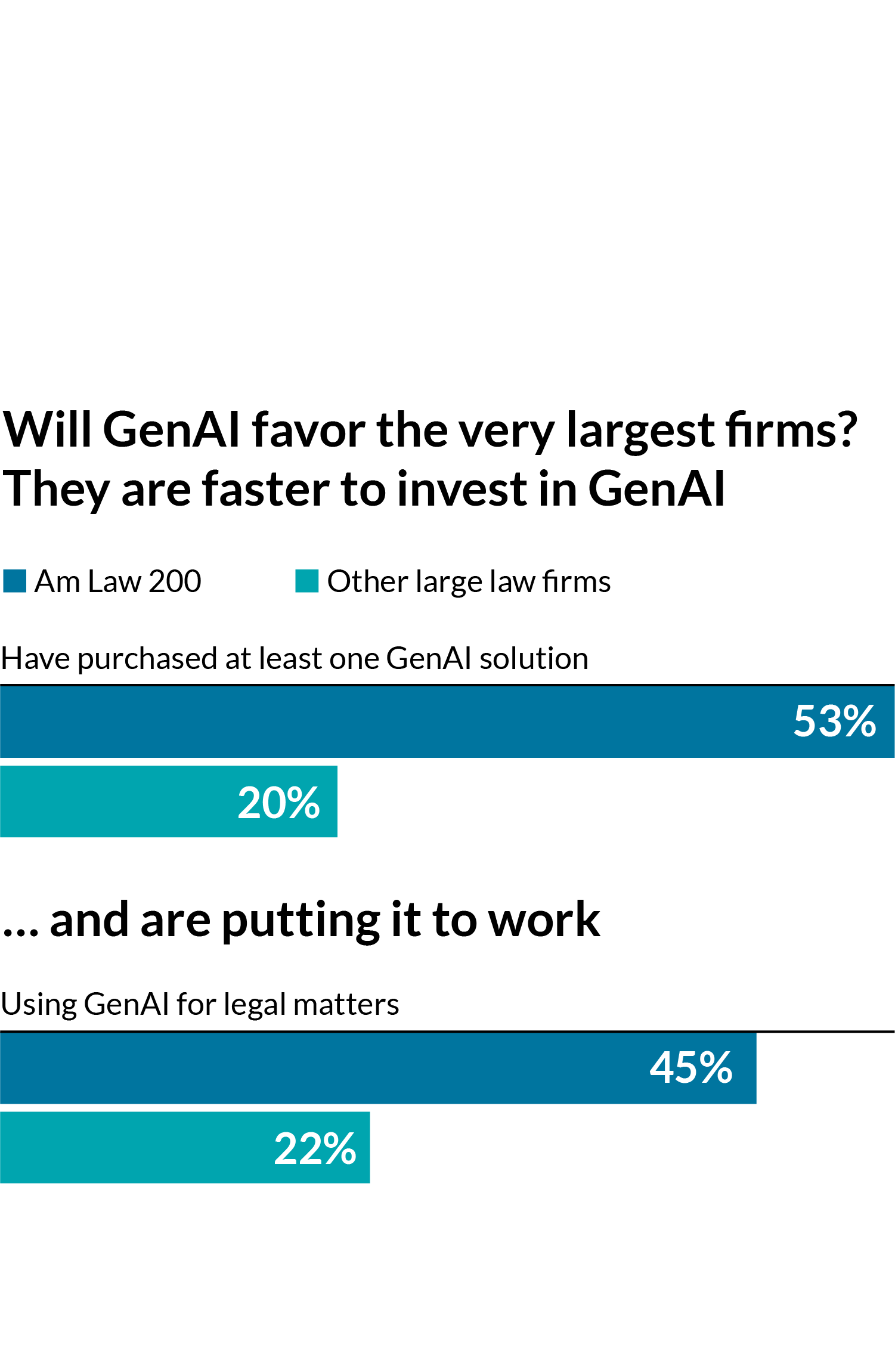GenAI in Law:
Unlocking New Revenues
This remarkable technology can help lawyers build innovative products and services

The explosion in Generative AI (GenAI) technology is changing the way lawyers work, streamlining and automating processes such as research and drafting. For law firm leaders that open their minds to progress, it also has the potential to create new revenue streams for law firms and drive practice growth.
More than half of senior lawyers at Am Law 200 firms (54%) believe GenAI can help them expand into new business areas or take advantage of new billable opportunities, according to the 2024 LexisNexis Investing in Legal Innovation Survey. By freeing up lawyer capacity, firms will be able to offer more services to existing clients or more easily absorb new clients, boosting profitability.
This report explores how firms can use GenAI tools to innovate and provide new services for clients—and even help improve margins in practice areas that have been less profitable. It also highlights the challenges firms must navigate and the AI skills and expertise they will need to succeed in this fast-evolving field.
The explosion in Generative AI (GenAI) technology is changing the way lawyers work, streamlining and automating processes such as research and drafting. For law firm leaders that open their minds to progress, it also has the potential to create new revenue streams for law firms and drive practice growth.
More than half of senior lawyers at Am Law 200 firms (54%) believe GenAI can help them expand into new business areas or take advantage of new billable opportunities, according to the 2024 LexisNexis Investing in Legal Innovation Survey. By freeing up lawyer capacity, firms will be able to offer more services to existing clients or more easily absorb new clients, boosting profitability.
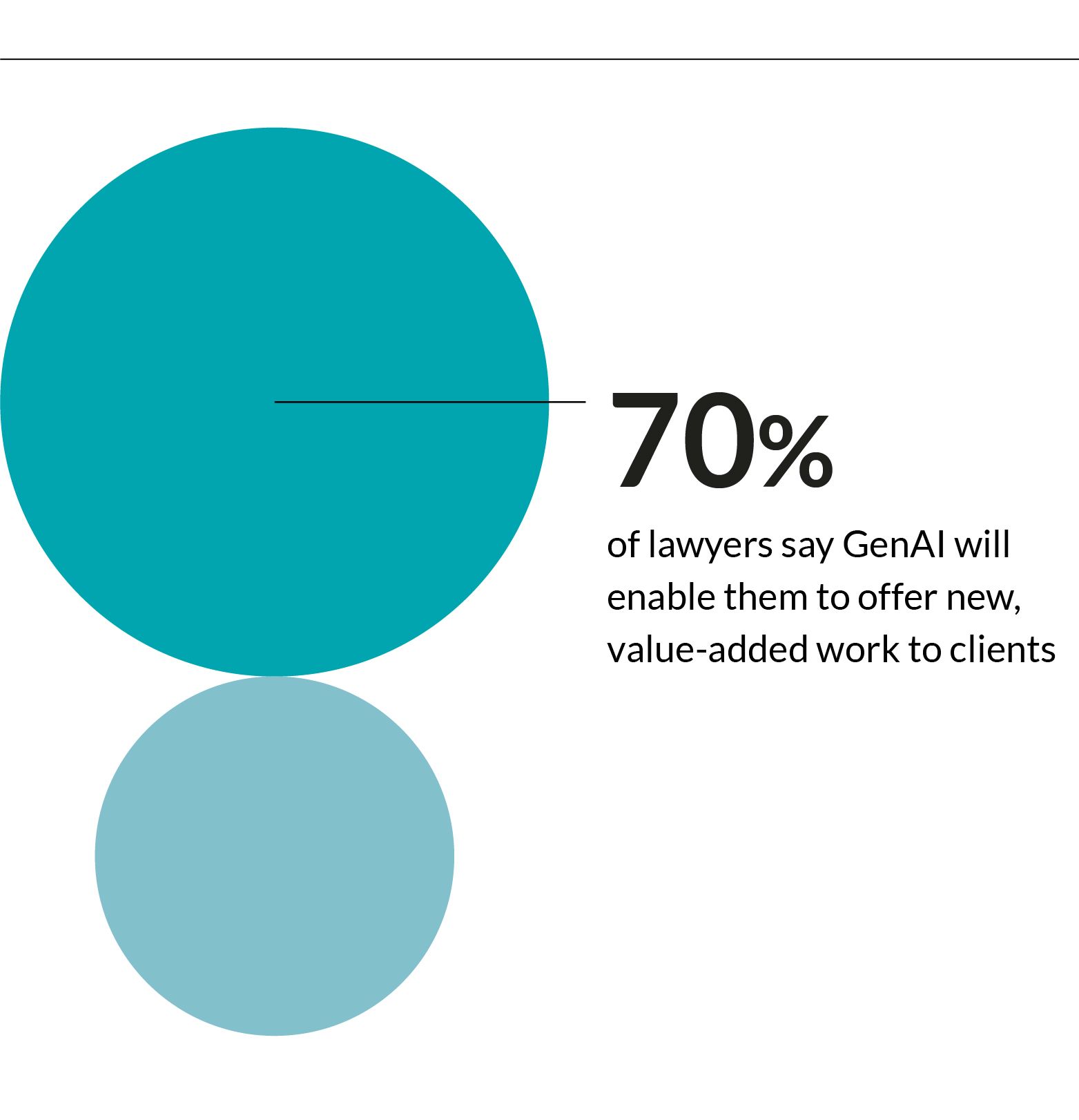
This report explores how firms can use GenAI tools to innovate and provide new services for clients—and even help improve margins in practice areas that have been less profitable. It also highlights the challenges firms must navigate and the AI skills and expertise they will need to succeed in this fast-evolving field.
Meet your new business development tool: GenAI
The legal services market is being disrupted, creating fresh revenue opportunities

Finding new business opportunities may become easier with GenAI. Not only can GenAI unlock efficiency gains that enable lawyers to focus on higher-value work, it can also help them expand into new practice areas. There is a degree of urgency too. With some law firms already implementing GenAI initiatives and AI innovation happening at breakneck pace, firms that move too slowly could get left behind.
While there are trust issues to work through—see the first report in this series, downloadable here—the vast majority of lawyers are optimistic about the potential for GenAI in the legal profession. As many as 77% of senior lawyers at Am Law 200 firms believe GenAI will enable them to offer new value-added services to clients, with 54% saying they are already exploring these potential opportunities.
Firms are looking at generative AI in different ways, says Jeff Pfeifer, Chief Product Officer at LexisNexis. Some seek to use the technology to complete work faster, while others want to create capacity to either grow their existing practices or move into new practice areas, he says.
Some law firm leaders believe it can help them adjust their business models and become more competitive.
“The business opportunities are being able to do more fixed fee or alternative fee arrangements due to the fact that some time-sensitive work can be done more quickly,” says James Metzger, Chief Financial Officer at Reed Smith. In these instances, “lawyers can provide more analysis for the same cost, or what would have been costly legal work can be done at a lower price point.”
Metzger also expects GenAI will reverse the offshoring trend where certain low-value work has been outsourced to legal ops teams in lower-cost jurisdictions. It may also open “lower profitability segments of the market” where it may not have previously made financial sense for Reed Smith to compete.
This may also extend to boosting the profitability of certain types of legal work within an existing practice group where margins were not as attractive.
“It will allow us to take sub-practices that may not be as profitable to the firm as a whole and really use GenAI to drive the profitability of those practices,” says Metzger. “This then allows the firm to provide a full service to clients where in the past we might not have had a specialty that a client is looking for just because the volume at that scale was not profitable.”
For some firms, adopting AI is not just about immediate efficiency benefits—it is also about using the technology to gain a competitive advantage in the courtroom or at the bargaining table.
The survey shows that the largest law firms see the biggest opportunities with GenAI. More than half of Am Law 200 firms (54%) say they are exploring new lines of business made possible by the technology, compared to 38% of other firms.
Those firms that see the biggest opportunities—such as McGuireWoods—are also more likely to hire specialist roles to oversee AI deployment, creating a Chief Innovation & AI Officer role. Reed Smith has also hired a Chief Innovation Officer whose remit includes AI, says Metzger.
Aside from the potential to deploy GenAI internally to create new value-added services for clients, the explosion of GenAI technology is also creating work for lawyers. Lawsuits have proliferated over questions of copyright infringement and fair use around training data, while there are also data privacy issues to consider, says Tod Cohen, a Partner at Steptoe.
Companies may also face bias and discrimination issues over AI use, particularly in job hiring situations where AI pre-vets applications. This could lead to more work for employment and labor lawyers, Cohen says.
Five potential GenAI legal use cases
While AI has been used in legal technology applications for some time, GenAI opens up a realm of new possibilities to streamline how lawyers work.
Legal research - lawyers can ask legal GenAI assistants to quickly find and summarize the information they need, making legal research more efficient.
AI assistant - similar to Microsoft’s Copilot, a legal GenAI assistant can support lawyers with multiple tasks, all personalized to that individual lawyer’s preferences.
Predictive legal analytics – legal GenAI can analyze the characteristics of a particular case and predict case outcomes by analyzing similar cases, helping inform more strategic litigation decisions.
Faster contract drafting – legal GenAI can generate contracts that are tailored to specific client needs.
IP prosecution work – legal GenAI can help lawyers do faster patent and trademark search and analysis.
Finding new business opportunities may become easier with GenAI. Not only can GenAI unlock efficiency gains that enable lawyers to focus on higher-value work, it can also help them expand into new practice areas. There is a degree of urgency too. With some law firms already implementing GenAI initiatives and AI innovation happening at breakneck pace, firms that move too slowly could get left behind.
While there are trust issues to work through—see the first report in this series, downloadable here—the vast majority of lawyers are optimistic about the potential for GenAI in the legal profession. As many as 77% of senior lawyers at Am Law 200 firms believe GenAI will enable them to offer new value-added services to clients, with 54% saying they are already exploring these potential opportunities.
Firms are looking at generative AI in different ways, says Jeff Pfeifer, Chief Product Officer at LexisNexis. Some seek to use the technology to complete work faster, while others want to create capacity to either grow their existing practices or move into new practice areas, he says.
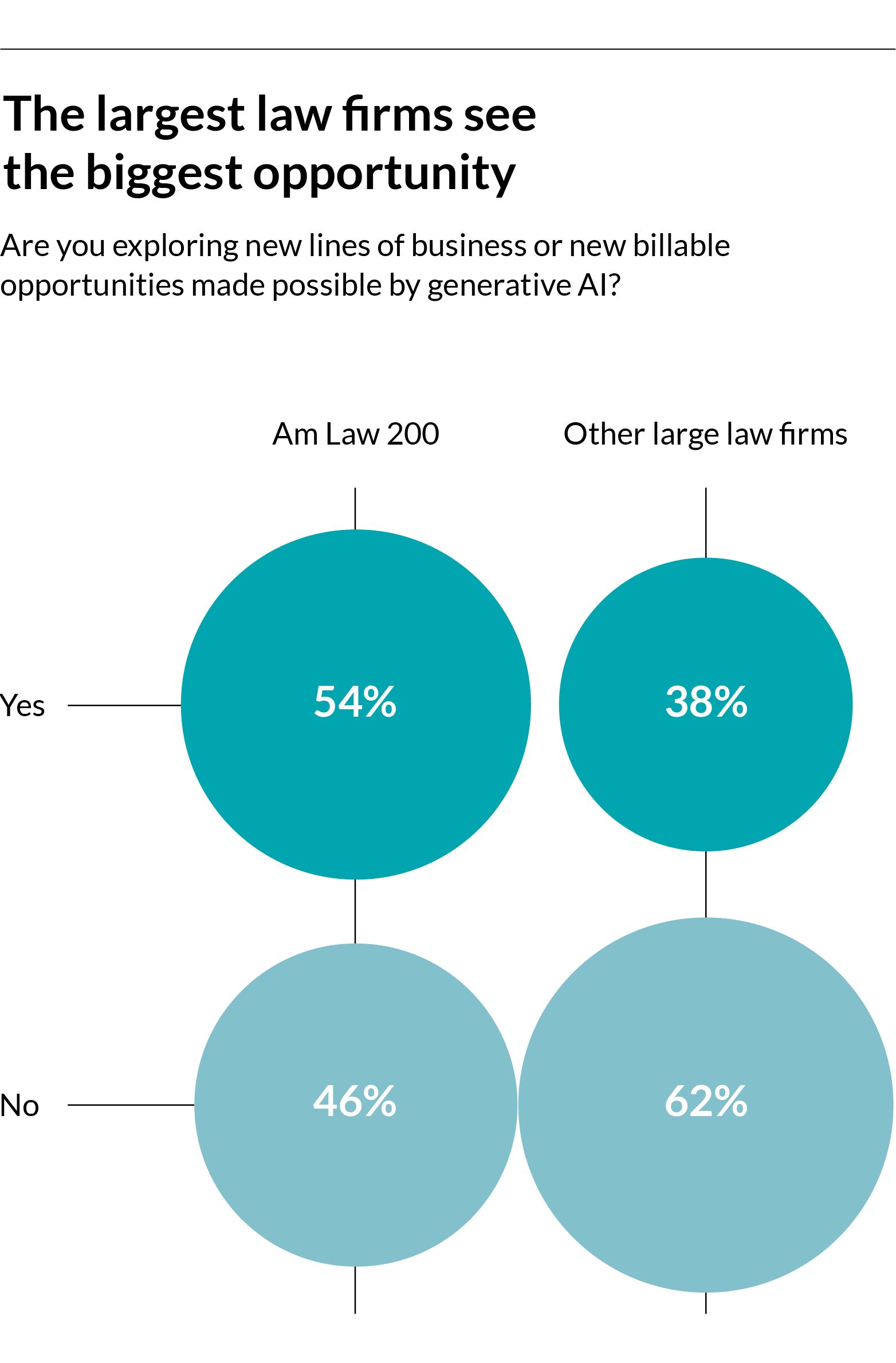
Some law firm leaders believe it can help them adjust their business models and become more competitive.
“The business opportunities are being able to do more fixed fee or alternative fee arrangements due to the fact that some time-sensitive work can be done more quickly,” says James Metzger, Chief Financial Officer at Reed Smith. In these instances, “lawyers can provide more analysis for the same cost, or what would have been costly legal work can be done at a lower price point.”
Metzger also expects GenAI will reverse the offshoring trend where certain low-value work has been outsourced to legal ops teams in lower-cost jurisdictions. It may also open “lower profitability segments of the market” where it may not have previously made financial sense for Reed Smith to compete.
This may also extend to boosting the profitability of certain types of legal work within an existing practice group where margins were not as attractive.
“It will allow us to take sub-practices that may not be as profitable to the firm as a whole and really use GenAI to drive the profitability of those practices,” says Metzger. “This then allows the firm to provide a full service to clients where in the past we might not have had a specialty that a client is looking for just because the volume at that scale was not profitable.”
For some firms, adopting AI is not just about immediate efficiency benefits—it is also about using the technology to gain a competitive advantage in the courtroom or at the bargaining table.
The survey shows that the largest law firms see the biggest opportunities with GenAI. More than half of Am Law 200 firms (54%) say they are exploring new lines of business made possible by the technology, compared to 38% of other firms.
Those firms that see the biggest opportunities—such as McGuireWoods—are also more likely to hire specialist roles to oversee AI deployment, creating a Chief Innovation & AI Officer role. Reed Smith has also hired a Chief Innovation Officer whose remit includes AI, says Metzger.
Aside from the potential to deploy GenAI internally to create new value-added services for clients, the explosion of GenAI technology is also creating work for lawyers. Lawsuits have proliferated over questions of copyright infringement and fair use around training data, while there are also data privacy issues to consider, says Tod Cohen, a Partner at Steptoe.
Companies may also face bias and discrimination issues over AI use, particularly in job hiring situations where AI pre-vets applications. This could lead to more work for employment and labor lawyers, Cohen says.
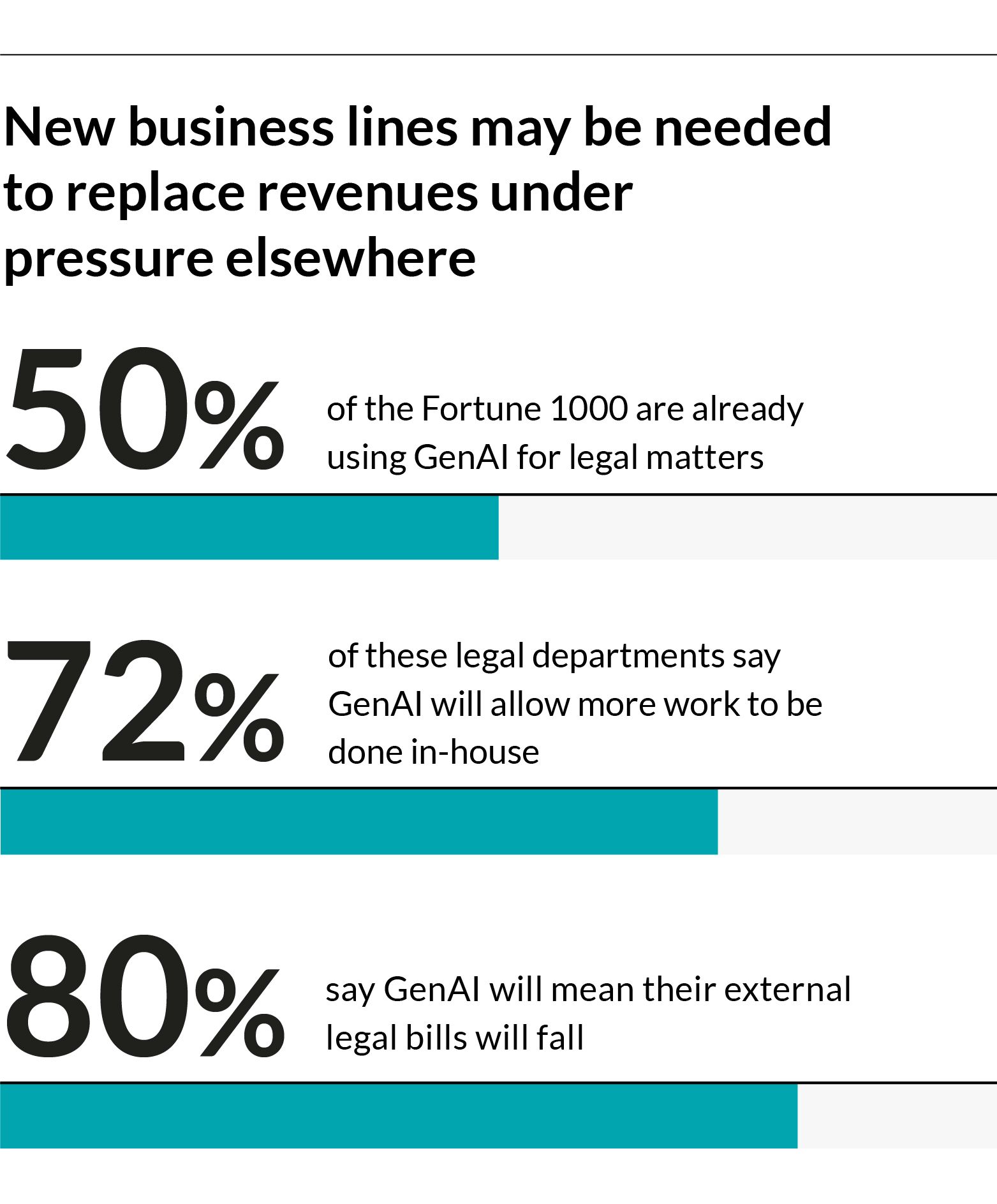
Five potential GenAI legal use cases
While AI has been used in legal technology applications for some time, GenAI opens up a realm of new possibilities to streamline how lawyers work.
Legal research - lawyers can ask legal GenAI assistants to quickly find and summarize the information they need, making legal research more efficient.
AI assistant - similar to Microsoft’s Copilot, a legal GenAI assistant can support lawyers with multiple tasks, all personalized to that individual lawyer’s preferences.
Predictive legal analytics – legal GenAI can analyze the characteristics of a particular case and predict case outcomes by analyzing similar cases, helping inform more strategic litigation decisions.
Faster contract drafting – legal GenAI can generate contracts that are tailored to specific client needs.
IP prosecution work – legal GenAI can help lawyers do faster patent and trademark search and analysis.
The client question
GenAI will accelerate changes to client mindset when it comes to assessing the value of legal work

As firms increasingly adopt GenAI into their workflows and reduce the time lawyers need to spend on labor-intensive tasks—document review, say—it may change perceptions about the value of that work for clients and what they are prepared to pay for legal services. For example, the survey shows that 80% of in-house teams believe that the adoption of GenAI means their external legal bills will fall.
“Corporate counsel do expect that their law firms using this technology are going to deliver business benefits back to them, so that might mean faster or more efficient production of the information,” says Pfeifer. “Ultimately, they expect to see some financial benefit in the way their work is managed by their outside counsel.”
Even so, some lawyers argue that time is not the only component clients are paying for and that completing work faster doesn’t devalue the nature of the work.
“The work still has to be accurate,” says Neil Posner, a Principal at Chicago law firm Much Shelist. “Just because something gets done more quickly because we used a fancy new form of technology doesn’t mean that we still do not owe you our diligence and competence. I’m not sure if that’s going to translate into significant cost savings.”
The emergence of GenAI tools is therefore unlikely to radically change the billing landscape, in part because GenAI is no different than other technologies that have helped law firms do work more efficiently, says Cohen. That type of work has already been carved into fixed-fee arrangements. For matters that require human judgment, GenAI is unlikely to have an impact on billable hour rates.
“The legal profession is more insulated than most, because ultimately most of the legal profession’s skill is in judgment and foresight—that’s what people pay an attorney for—and that’s the hardest part to translate to a machine,” says Cohen.
However, some in-house teams do expect to see some impact on their bills, even if it is just a change in the nature of work they are billed for.
“I think as GenAI becomes widely used we would expect to see a shift in how time is billed to us,” says Christy Jo Gedney, Senior Manager at Liberty Mutual Insurance. “I would expect to be billed more for detailed legal strategy, risk analysis and the refinement of legal documents and less for the routine analysis and for the initial drafting of documents.”
The impact on billable hours is also less likely to be felt at the partner or even the senior associate level, given that GenAI is likely only to reduce hours on work carried out by more junior lawyers who tend to get handed the high-volume tasks that the technology could handle instead, Cohen says.
That could have two key implications for law firm business models, says the Head of Knowledge Management at a top 150 US law firm.
“The first is how do we price our services so that we’re being properly compensated for a valuable delivery,” the Knowledge Management Head says. “The second is the impact on associate training.”
While law schools in the US have made considerable advancements, they still don’t train lawyers in specific areas of law—something that law firms must do themselves when hiring junior associates.
“If a lot of the work that they are traditionally doing is taken away from them and given to GenAI, then how do you make sure they’re getting the training they need so that when they’re a mid-level associate, they can be doing that higher value work?” the Knowledge Management Head adds.
Clients are also increasingly expecting their law firms to use GenAI tools. More than three-quarters of in-house respondents (76%) either agree or strongly agree that they expect their law firms to use cutting-edge technology, including GenAI.
“It’s not that they’re asking that GenAI be used, there’s just an assumption that it’s going to be used,” says Cohen.
In-house teams are also exploring using GenAI themselves. Half of Fortune 1000 companies are already using GenAI for legal matters, while almost three-quarters of them (72%) say GenAI will allow them to keep more work in-house, according to the survey. That doesn’t mean, however, that law firms are going to see inbound work slowdown.
“Generally speaking, the focus for application of generative AI in corporate legal departments is not the work that they send to outside counsel,” says Pfeifer. “In-house counsel describes their primary responsibility as responding to the legal needs of their business. So if you are a lawyer in a corporation, your primary responsibility is answering the legal questions that come from other parts of your organization and that type of legal work is actually not what is sent to outside counsel.”
As firms increasingly adopt GenAI into their workflows and reduce the time lawyers need to spend on labor-intensive tasks—document review, say—it may change perceptions about the value of that work for clients and what they are prepared to pay for legal services. For example, the survey shows that 80% of in-house teams believe that the adoption of GenAI means their external legal bills will fall.
“Corporate counsel do expect that their law firms using this technology are going to deliver business benefits back to them, so that might mean faster or more efficient production of the information,” says Pfeifer. “Ultimately, they expect to see some financial benefit in the way their work is managed by their outside counsel.”
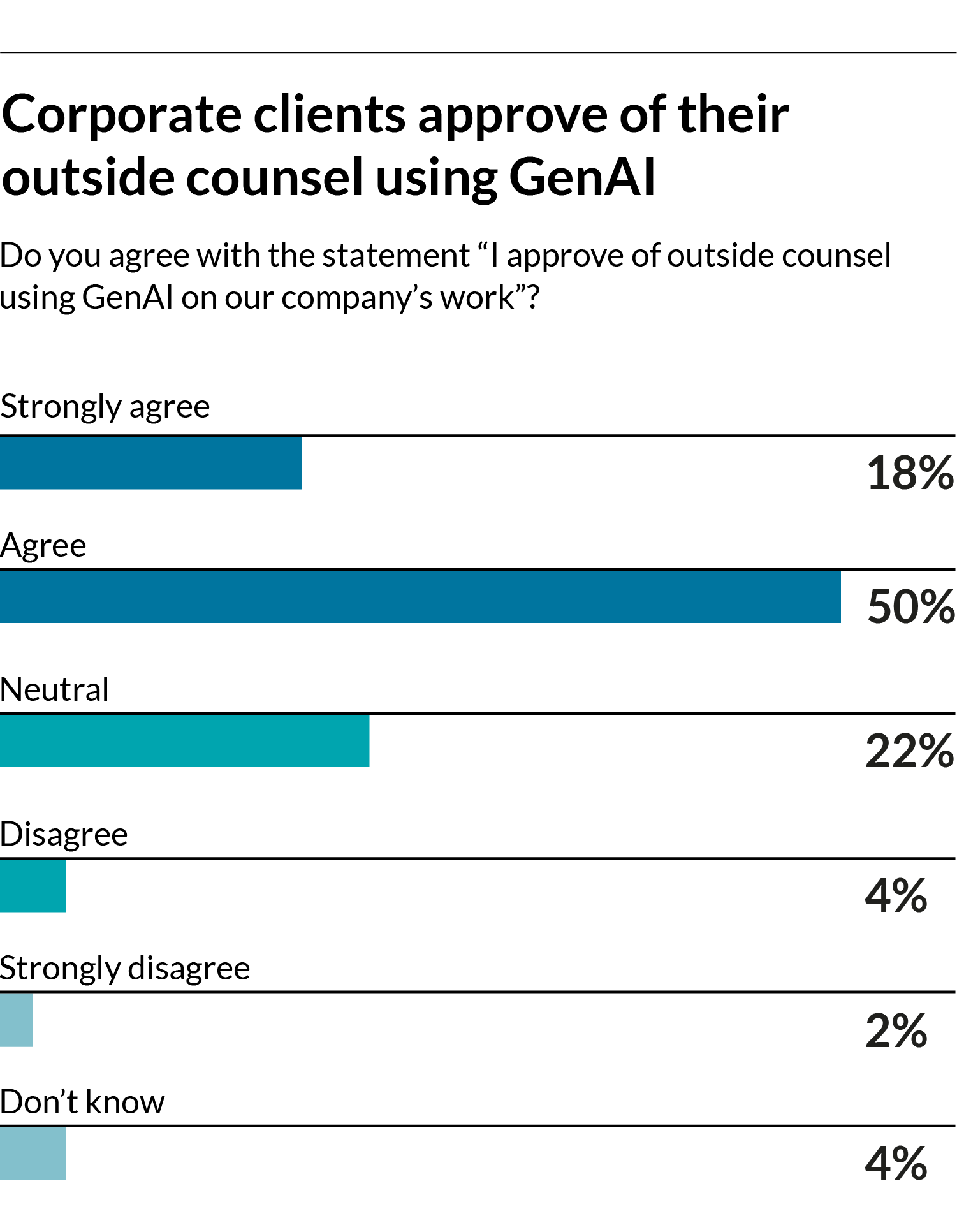
Even so, some lawyers argue that time is not the only component clients are paying for and that completing work faster doesn’t devalue the nature of the work.
“The work still has to be accurate,” says Neil Posner, a Principal at Chicago law firm Much Shelist. “Just because something gets done more quickly because we used a fancy new form of technology doesn’t mean that we still do not owe you our diligence and competence. I’m not sure if that’s going to translate into significant cost savings.”
The emergence of GenAI tools is therefore unlikely to radically change the billing landscape, in part because GenAI is no different than other technologies that have helped law firms do work more efficiently, says Cohen. That type of work has already been carved into fixed-fee arrangements. For matters that require human judgment, GenAI is unlikely to have an impact on billable hour rates.
“The legal profession is more insulated than most, because ultimately most of the legal profession’s skill is in judgment and foresight—that’s what people pay an attorney for—and that’s the hardest part to translate to a machine,” says Cohen.
However, some in-house teams do expect to see some impact on their bills, even if it is just a change in the nature of work they are billed for.
“I think as GenAI becomes widely used we would expect to see a shift in how time is billed to us,” says Christy Jo Gedney, Senior Manager at Liberty Mutual Insurance. “I would expect to be billed more for detailed legal strategy, risk analysis and the refinement of legal documents and less for the routine analysis and for the initial drafting of documents.”
The impact on billable hours is also less likely to be felt at the partner or even the senior associate level, given that GenAI is likely only to reduce hours on work carried out by more junior lawyers who tend to get handed the high-volume tasks that the technology could handle instead, Cohen says.
That could have two key implications for law firm business models, says the Head of Knowledge Management at a top 150 US law firm.
“The first is how do we price our services so that we’re being properly compensated for a valuable delivery,” the Knowledge Management Head says. “The second is the impact on associate training.”
While law schools in the US have made considerable advancements, they still don’t train lawyers in specific areas of law—something that law firms must do themselves when hiring junior associates.
“If a lot of the work that they are traditionally doing is taken away from them and given to GenAI, then how do you make sure they’re getting the training they need so that when they’re a mid-level associate, they can be doing that higher value work?” the Knowledge Management Head adds.
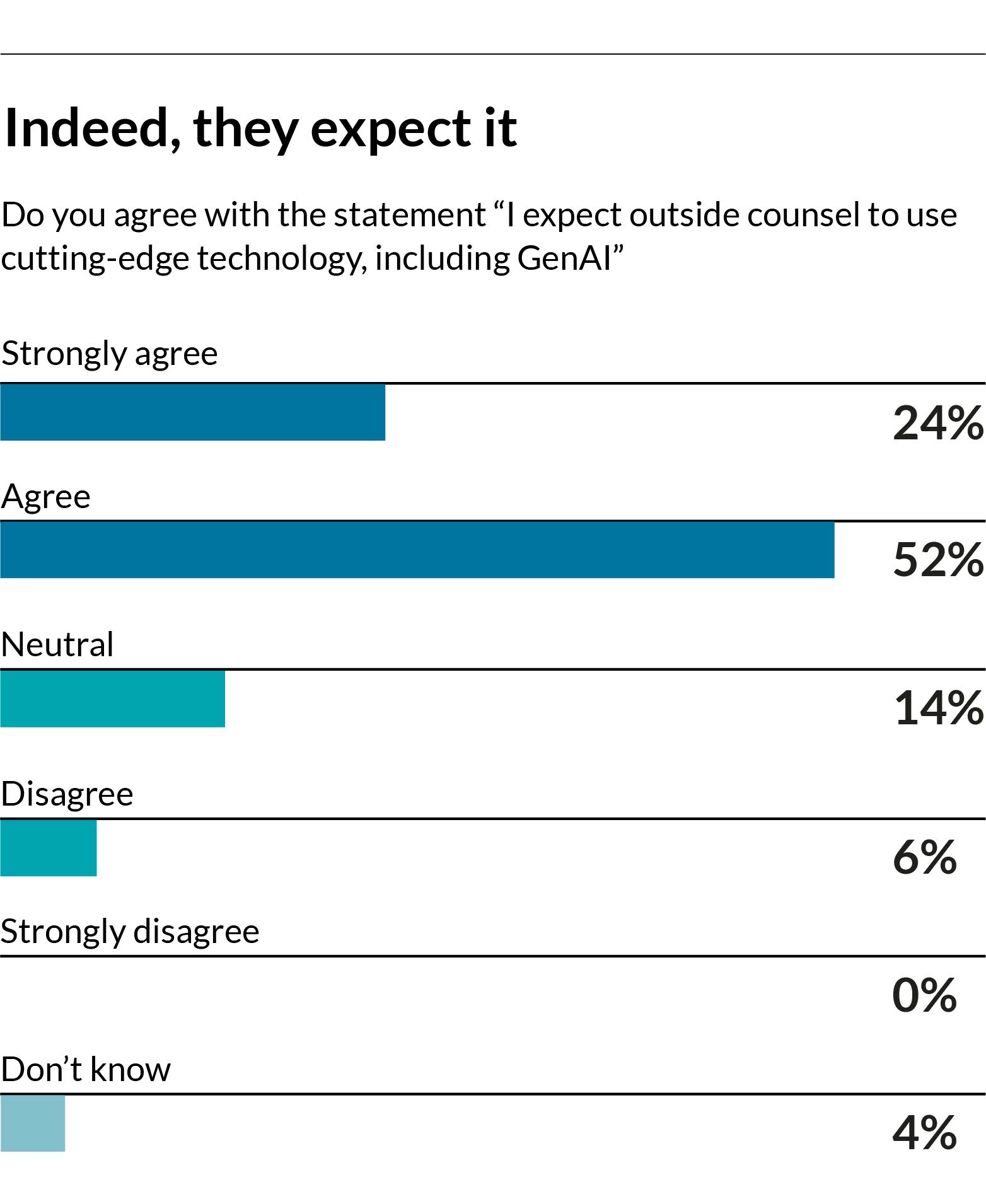
Clients are also increasingly expecting their law firms to use GenAI tools. More than three-quarters of in-house respondents (76%) either agree or strongly agree that they expect their law firms to use cutting-edge technology, including GenAI.
“It’s not that they’re asking that GenAI be used, there’s just an assumption that it’s going to be used,” says Cohen.
In-house teams are also exploring using GenAI themselves. Half of Fortune 1000 companies are already using GenAI for legal matters, while almost three-quarters of them (72%) say GenAI will allow them to keep more work in-house, according to the survey. That doesn’t mean, however, that law firms are going to see inbound work slowdown.
“Generally speaking, the focus for application of generative AI in corporate legal departments is not the work that they send to outside counsel,” says Pfeifer. “In-house counsel describes their primary responsibility as responding to the legal needs of their business. So if you are a lawyer in a corporation, your primary responsibility is answering the legal questions that come from other parts of your organization and that type of legal work is actually not what is sent to outside counsel.”
Making it happen
Seizing the opportunity will be easier with the right skills in place

Adopting GenAI tools in law firms means lawyers will need to be proficient in prompting so they can interact with the technology and use it effectively. It is also likely to lead to new job roles in law firms to oversee adoption. For example, more than a third of senior Am Law 200 lawyers (38%) say their firms are planning to hire technologists such as data scientists or engineers to support their GenAI programs, according to the survey.
While lawyers may not need to become AI technologists, firms will increasingly expect lawyers to have some degree of understanding of how to use GenAI tools when they are making new hires.
“Firms will be looking for people that will be able to integrate the tools into their day-to-day activities,” says Cohen. “Five years ago, we wouldn’t have guessed that Zoom would be used as much. Yes, there was a pandemic. But if you don’t use Zoom or you don’t use any type of video conferencing, you’re not really doing any work in most instances, so it’s really just about trying to get GenAI integrated without any effort by the attorneys.”
Firms may also need to accelerate their GenAI programs if they want to attract the best new graduates.
“What we’ve seen when hiring new associates out of law school, during the recruitment process they’re asking questions about legal tech and legal GenAI, and if your firm is not using these tools, you’re viewed as old-fashioned, stodgy, and maybe a place that the best candidates don’t want to work,” says Geovanes.
Rather than seeking to hire specialist AI expertise internally, many firms are taking a partnership approach to AI adoption by outsourcing that expertise to third parties.
“That makes sense because if you think about how competitive the space is to acquire the kinds of skills needed to execute an AI strategy, it’s likely that law firms could be challenged by the large number of tech companies trying to recruit those same skills,” says Pfeifer.
Law firms may also increasingly lean on non-fee earning lawyers or other support staff such as knowledge management attorneys or librarians to advance their AI use.
“There is a need for specialist searching and research that the tools certainly will enhance, so there will be people using GenAI tools to assist in research and librarians are going to have a large role in this,” says Cohen.
Data is also going to become increasingly important for firms that are adopting GenAI tools, with some already setting up data analytics groups to support their AI initiatives.
“If you want to use GenAI properly, you have to have solid data, and you have to know how to use it and how to structure things,” says the Head of Knowledge Management at a top 150 US firm. “So I do think that it's going to change the way law firms approach staffing."
Some law firms are hiring knowledge managers or so-called query engineers—“people who can actually really focus on leveraging GenAI across the firm's knowledge resources”, the Knowledge Management Head says. Junior associates will also need to be more tech savvy to navigate this changing legal environment.
“I think GenAI is going to highlight the importance of knowledge management and maybe clarify its value for those who haven't already figured that out,” the Knowledge Management Head adds.
Some law firms like McGuireWoods are seeking to build cross-functional AI teams by not just training attorneys but paralegals, legal researchers, training professionals as well as IT teams members.
“We’re trying to pollinate these groups with foundational GenAI skills so as we roll out AI tools to everyone in the firm, we will have grassroots champions that can lend support,” Geovanes says.
Adopting GenAI tools in law firms means lawyers will need to be proficient in prompting so they can interact with the technology and use it effectively. It is also likely to lead to new job roles in law firms to oversee adoption. For example, more than a third of senior Am Law 200 lawyers (38%) say their firms are planning to hire technologists such as data scientists or engineers to support their GenAI programs, according to the survey.
While lawyers may not need to become AI technologists, firms will increasingly expect lawyers to have some degree of understanding of how to use GenAI tools when they are making new hires.
“Firms will be looking for people that will be able to integrate the tools into their day-to-day activities,” says Cohen. “Five years ago, we wouldn’t have guessed that Zoom would be used as much. Yes, there was a pandemic. But if you don’t use Zoom or you don’t use any type of video conferencing, you’re not really doing any work in most instances, so it’s really just about trying to get GenAI integrated without any effort by the attorneys.”
Firms may also need to accelerate their GenAI programs if they want to attract the best new graduates.
“What we’ve seen when hiring new associates out of law school, during the recruitment process they’re asking questions about legal tech and legal GenAI, and if your firm is not using these tools, you’re viewed as old-fashioned, stodgy, and maybe a place that the best candidates don’t want to work,” says Geovanes.
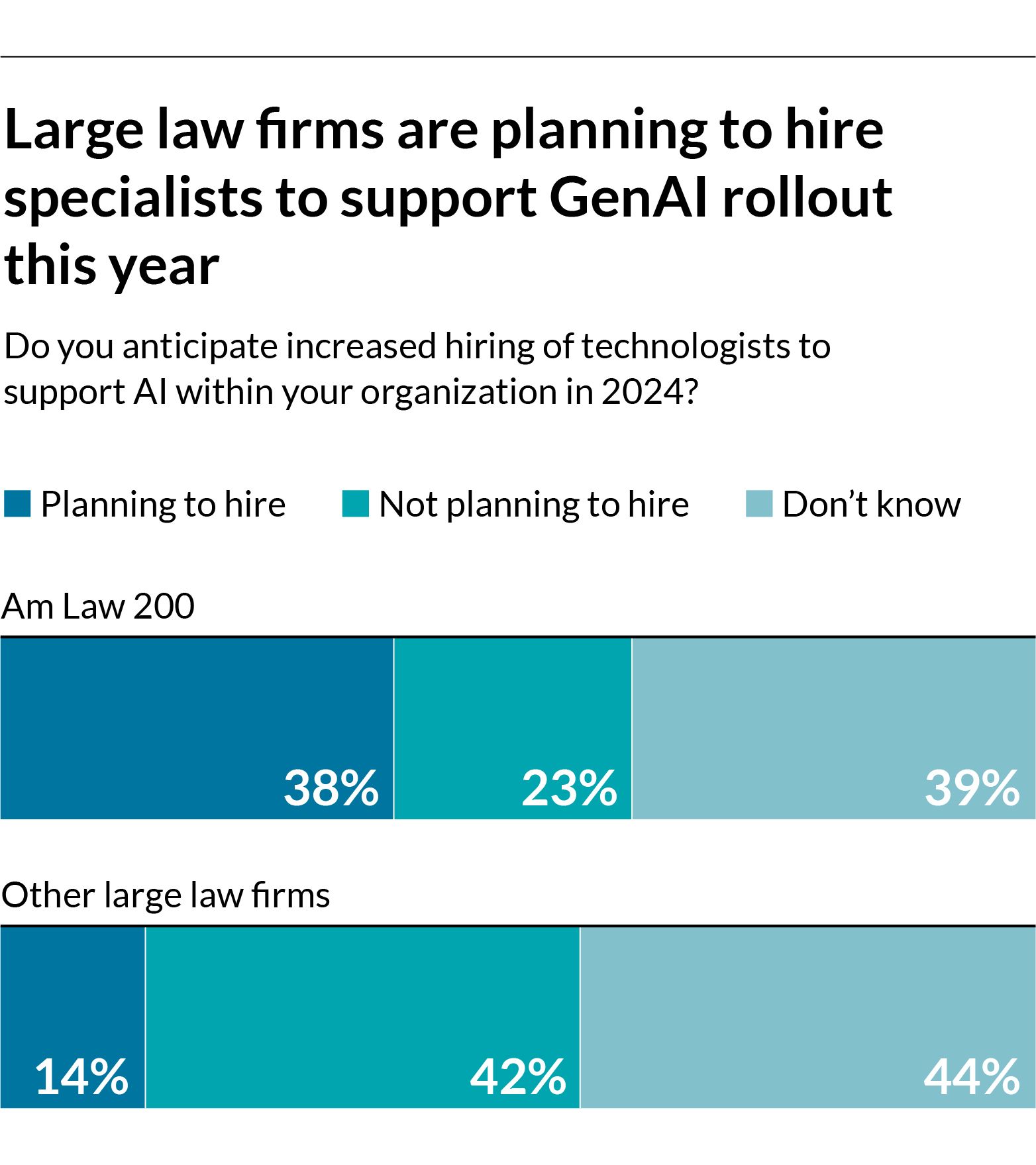
Rather than seeking to hire specialist AI expertise internally, many firms are taking a partnership approach to AI adoption by outsourcing that expertise to third parties.
“That makes sense because if you think about how competitive the space is to acquire the kinds of skills needed to execute an AI strategy, it’s likely that law firms could be challenged by the large number of tech companies trying to recruit those same skills,” says Pfeifer.
Law firms may also increasingly lean on non-fee earning lawyers or other support staff such as knowledge management attorneys or librarians to advance their AI use.
“There is a need for specialist searching and research that the tools certainly will enhance, so there will be people using GenAI tools to assist in research and librarians are going to have a large role in this,” says Cohen.
Data is also going to become increasingly important for firms that are adopting GenAI tools, with some already setting up data analytics groups to support their AI initiatives.
“If you want to use GenAI properly, you have to have solid data, and you have to know how to use it and how to structure things,” says the Head of Knowledge Management at a top 150 US firm. “So I do think that it's going to change the way law firms approach staffing."
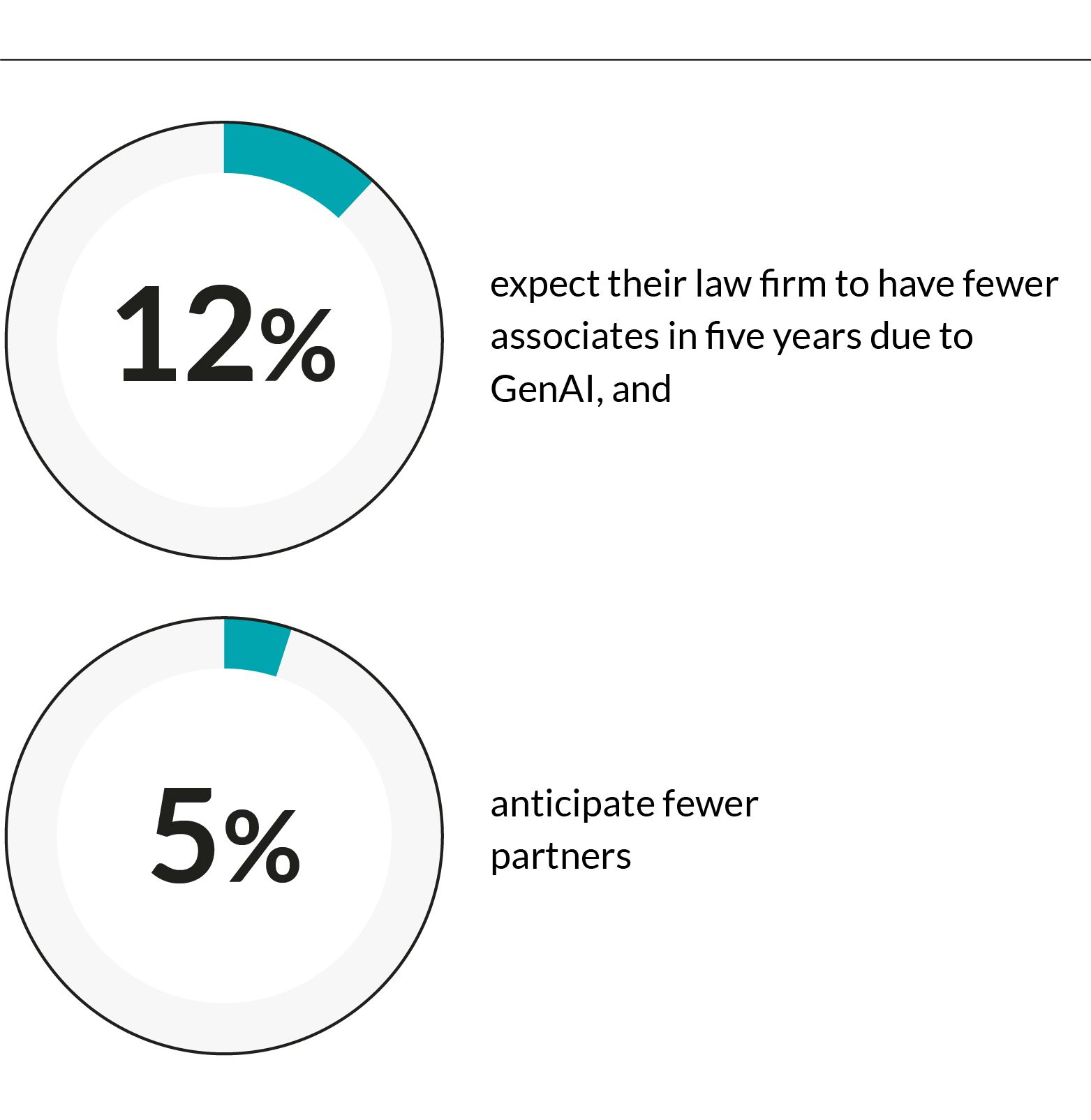
Some law firms are hiring knowledge managers or so-called query engineers—“people who can actually really focus on leveraging GenAI across the firm's knowledge resources”, the Knowledge Management Head says. Junior associates will also need to be more tech savvy to navigate this changing legal environment.
“I think GenAI is going to highlight the importance of Knowledge Management and maybe clarify its value for those who haven't already figured that out,” the Knowledge Management Head adds.
Some law firms like McGuireWoods are seeking to build cross-functional AI teams by not just training attorneys but paralegals, legal researchers, training professionals as well as IT teams members.
“We’re trying to pollinate these groups with foundational GenAI skills so as we roll out AI tools to everyone in the firm, we will have grassroots champions that can lend support,” Geovanes says.
How efficiency can create a new business
GenAI can transform unprofitable practice areas into thriving businesses

One of the key promises of GenAI tools is that they will help lawyers work more efficiently, freeing up capacity to take on more work or expand into new practice areas.
Clients that interact with GenAI tools and services from LexisNexis typically free up seven to 11 hours per week, says Pfeifer. “That’s a significant value driver for a legal organization,” he adds.
Attorneys use those extra hours to either follow up more rapidly on their next task or to expand services for the same client or other clients, Pfeifer adds.
In-house teams also expect to see GenAI free up lawyers’ time so they can focus on higher value work.
“We don't look at AI or GenAI as being replacements to attorneys, but rather tools that augment what those attorneys are able to do with their time,” says Gedney. “We want our attorneys, whether they’re in-house or outside counsel, to be practicing at the top of their licenses. We want them spending their time there doing the things that are impactful, such as building relationships or prepping for trial. Using GenAI tools will help give them the capacity to spend their time on more impactful matters.”
Liberty Mutual is also exploring how it could use GenAI to change the way the legal team interacts with business partners and external customers, adds Gedney.
This focus on efficiency is consistent across all firms that are exploring the potential of GenAI. The survey showed that the top priorities for using AI-powered tech are all efficiency-related, whether that is legal research (57%), summarizing documents (53%) or drafting documents (38%).
“In the legal sphere, it’s going to be initial drafts, it’s going to be research summaries, it’s going to be legislative monitoring,” says Cohen. “It’s all about who is going to take the first draft and GenAI tools are pretty well placed to do the first draft.”
Geovanes says McGuireWoods is starting to see notable efficiency gains through adopting GenAI for M&A due diligence by reviewing hundreds of contracts much faster than would be possible with a team of humans.
“The ability to use AI to surgically go into each one of those contracts and extract the information that you need and organize it into a spreadsheet as the first step of diligence can be a huge time saver,” he says.
While efficiency is currently the main priority, lawyers are also eyeing GenAI’s potential to support business growth opportunities. A quarter of respondents say using GenAI for business development reports is a top priority, with 21% saying they want to use GenAI for real-time comparisons of law across different jurisdictions and connecting GenAI to organizational data.
“I expect that we’ll see a focus on new lines of business and on advisory services that are proactive, rather than reactive,” says Pfeifer.
GenAI could also help practice areas where margins are under pressure to become more profitable through repeatable process improvements.
“We hear this consistently among the firms that we’re speaking with: they’re looking for ways technologies can make a material improvement in work quality and work efficiency. Doing so makes those lines of business more attractive from a margin perspective,” says Pfeifer.
One of the key promises of GenAI tools is that they will help lawyers work more efficiently, freeing up capacity to take on more work or expand into new practice areas.
Clients that interact with GenAI tools and services from LexisNexis typically free up seven to 11 hours per week, says Pfeifer. “That’s a significant value driver for a legal organization,” he adds.
Attorneys use those extra hours to either follow up more rapidly on their next task or to expand services for the same client or other clients, Pfeifer adds.
In-house teams also expect to see GenAI free up lawyers’ time so they can focus on higher value work.
“We don't look at AI or GenAI as being replacements to attorneys, but rather tools that augment what those attorneys are able to do with their time,” says Gedney. “We want our attorneys, whether they’re in-house or outside counsel, to be practicing at the top of their licenses. We want them spending their time there doing the things that are impactful, such as building relationships or prepping for trial. Using GenAI tools will help give them the capacity to spend their time on more impactful matters.”
Liberty Mutual is also exploring how it could use GenAI to change the way the legal team interacts with business partners and external customers, adds Gedney.
This focus on efficiency is consistent across all firms that are exploring the potential of GenAI. The survey showed that the top priorities for using AI-powered tech are all efficiency-related, whether that is legal research (57%), summarizing documents (53%) or drafting documents (38%).
“In the legal sphere, it’s going to be initial drafts, it’s going to be research summaries, it’s going to be legislative monitoring,” says Cohen. “It’s all about who is going to take the first draft and GenAI tools are pretty well placed to do the first draft.”
Geovanes says McGuireWoods is starting to see notable efficiency gains through adopting GenAI for M&A due diligence by reviewing hundreds of contracts much faster than would be possible with a team of humans.
“The ability to use AI to surgically go into each one of those contracts and extract the information that you need and organize it into a spreadsheet as the first step of diligence can be a huge time saver,” he says.
While efficiency is currently the main priority, lawyers are also eyeing GenAI’s potential to support business growth opportunities. A quarter of respondents say using GenAI for business development reports is a top priority, with 21% saying they want to use GenAI for real-time comparisons of law across different jurisdictions and connecting GenAI to organizational data.
“I expect that we’ll see a focus on new lines of business and on advisory services that are proactive, rather than reactive,” says Pfeifer.
GenAI could also help practice areas where margins are under pressure to become more profitable through repeatable process improvements.
“We hear this consistently among the firms that we’re speaking with: they’re looking for ways technologies can make a material improvement in work quality and work efficiency. Doing so makes those lines of business more attractive from a margin perspective,” says Pfeifer.

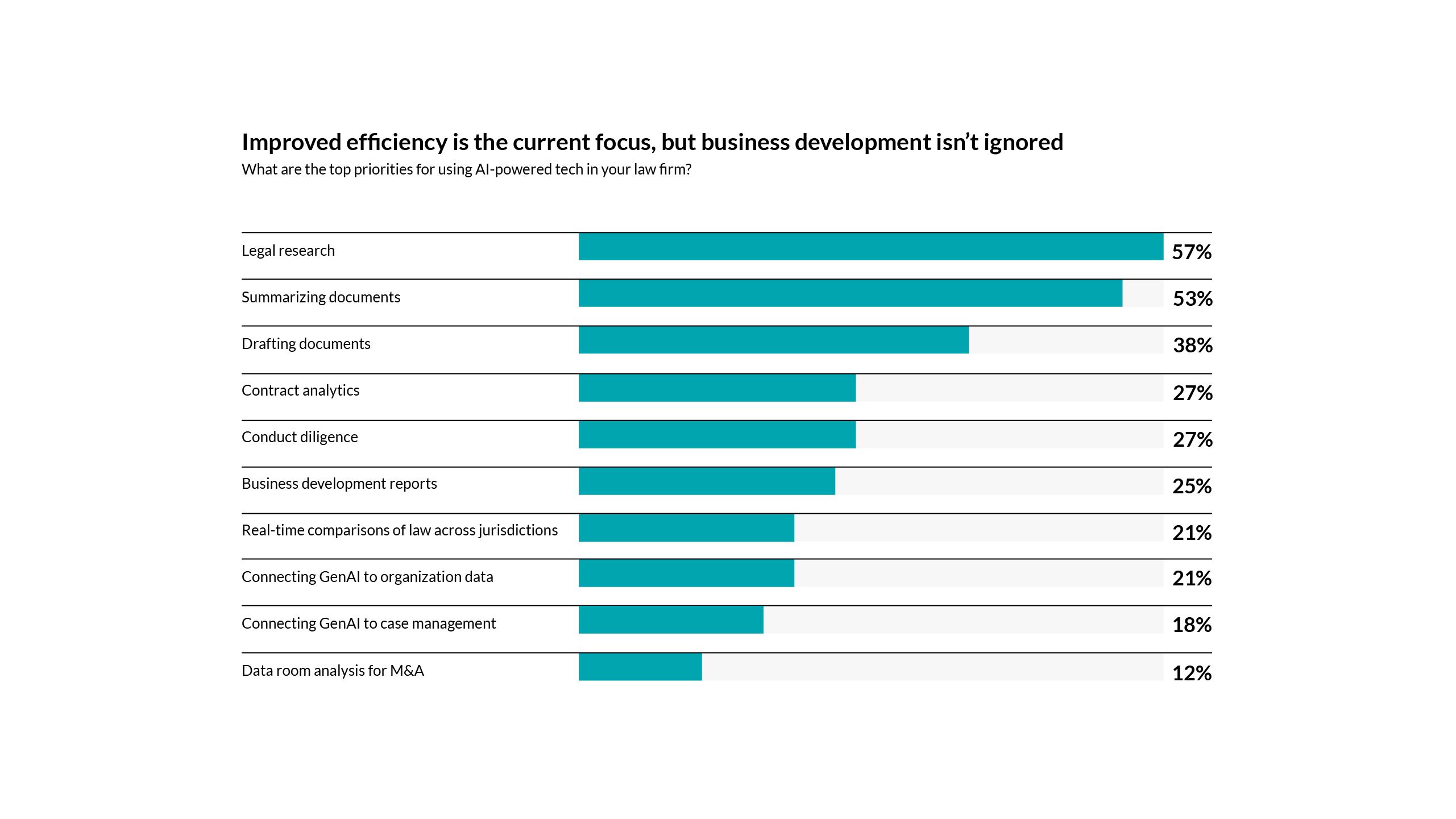
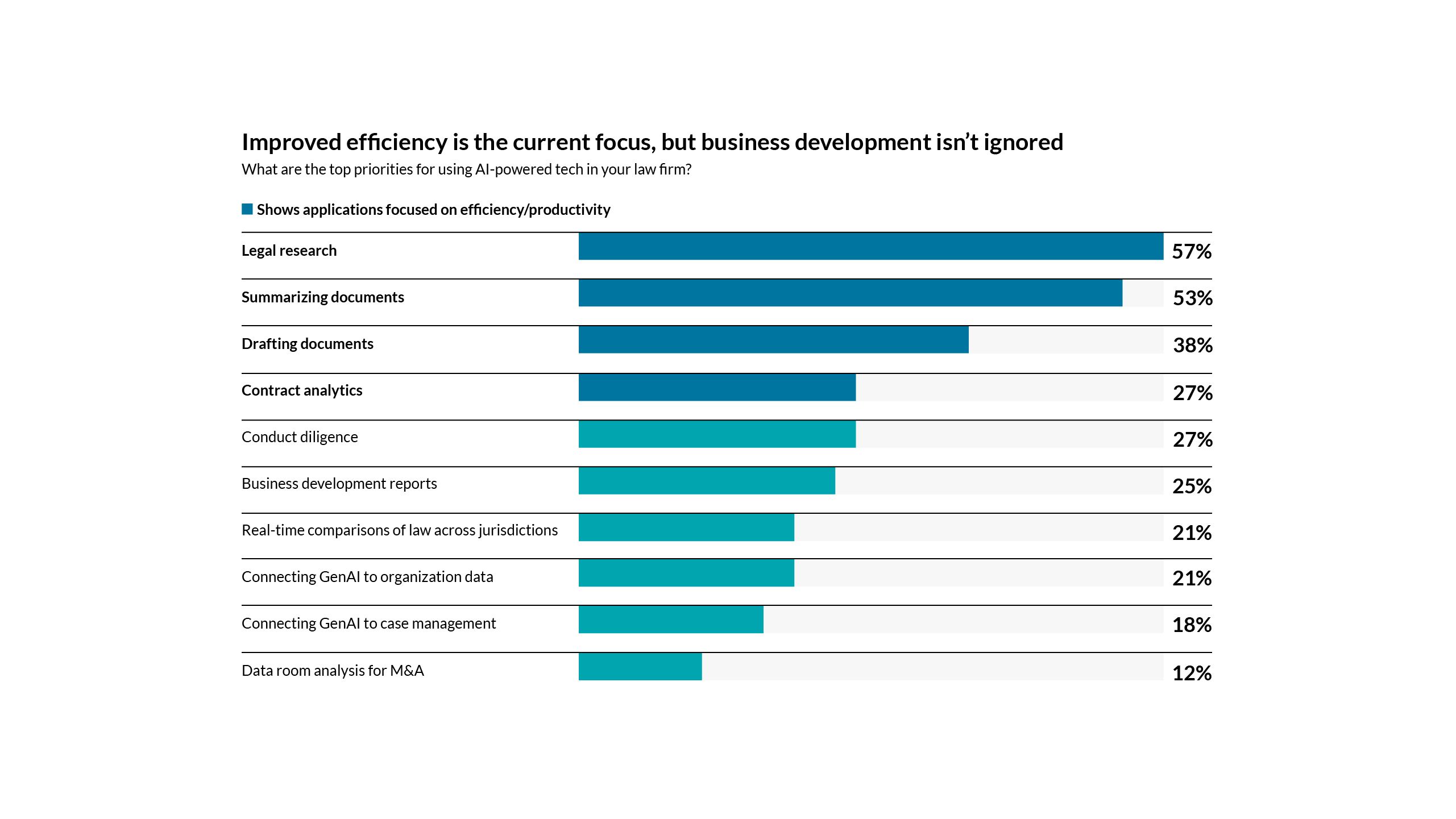
Conclusion: getting honest about the opportunities
Start business innovation now to maximize the chances of success

The pace of GenAI innovation means firms have little time to waste when thinking about how to adopt the technology—the biggest firms are already moving ahead. More than half of the Am Law 200 (53%) have purchased at least one GenAI solution and 45% of them are already using it for legal matters. For firms still on the fence, every minute of delay will put them further behind.
Unlike previous tech developments, where firms could generally move at their own pace, GenAI is taking the timeline out of their hands, says Pfeifer.
“There have not been many points in the last 30 years where a firm would be substantially disadvantaged by a slow adoption,” he says. “GenAI adoption is different because there are fundamental advantages that we’re seeing, not only in law but in other vertical industries, that create material differences in the way work is done. And so for a firm that’s slow on this front, they will find themselves in a constant mode of catch up.”
The good news, Pfeifer says, is that the opportunity has not yet passed—there is still time for firms to explore how they can use this technology. But the clock is ticking, and those that don’t take steps to embrace GenAI now will find themselves increasingly adrift in the coming months.
This means that while firms can be “fast followers,” they might not reap the same benefits as those that are leading the way, says Metzger.
"I do think firms that are on the leading edge are going to see the benefits of it and appreciate the benefits of it more than a firm that is just going to wait another 24 to 36 months to really see how it shapes out before they start to think about implementing,” he says.
The implications for firms that don’t move fast enough on GenAI may also become apparent in pricing as they won’t be able to compete with firms that can do the same work at a much lower cost.
“With the billable hour being what it is and not having those efficiencies being created by GenAI, other firms are going to take two, three, four times as long to do something as firms that have adopted GenAI can do,” says Krista Ford, Director of Knowledge, Research and Information Services at Steptoe & Johnson. “Firms that don’t adopt it will not be able to keep up with the volume of work and analysis that firms who are using GenAI can.”
By taking steps to adopt GenAI and transform their working practices, firms of all sizes have the potential to expand into new business areas and thrive in this new world. GenAI can help firms innovate and unlock new billing opportunities, while also improving client service by streamlining workflows and enabling lawyers to dedicate more hours to solving client problems. This can ultimately help firms become stronger and more competitive, driving faster growth and profitability.
The pace of GenAI innovation means firms have little time to waste when thinking about how to adopt the technology—the biggest firms are already moving ahead. More than half of the Am Law 200 (53%) have purchased at least one GenAI solution and 45% of them are already using it for legal matters. For firms still on the fence, every minute of delay will put them further behind.

Unlike previous tech developments, where firms could generally move at their own pace, GenAI is taking the timeline out of their hands, says Pfeifer.
“There have not been many points in the last 30 years where a firm would be substantially disadvantaged by a slow adoption,” he says. “GenAI adoption is different because there are fundamental advantages that we’re seeing, not only in law but in other vertical industries, that create material differences in the way work is done. And so for a firm that’s slow on this front, they will find themselves in a constant mode of catch up.”
The good news, Pfeifer says, is that the opportunity has not yet passed—there is still time for firms to explore how they can use this technology. But the clock is ticking, and those that don’t take steps to embrace GenAI now will find themselves increasingly adrift in the coming months.
This means that while firms can be “fast followers,” they might not reap the same benefits as those that are leading the way, says Metzger.
"I do think firms that are on the leading edge are going to see the benefits of it and appreciate the benefits of it more than a firm that is just going to wait another 24 to 36 months to really see how it shapes out before they start to think about implementing,” he says.
The implications for firms that don’t move fast enough on GenAI may also become apparent in pricing as they won’t be able to compete with firms that can do the same work at a much lower cost.
“With the billable hour being what it is and not having those efficiencies being created by GenAI, other firms are going to take two, three, four times as long to do something as firms that have adopted GenAI can do,” says Krista Ford, Director of Knowledge, Research and Information Services at Steptoe & Johnson. “Firms that don’t adopt it will not be able to keep up with the volume of work and analysis that firms who are using GenAI can.”
By taking steps to adopt GenAI and transform their working practices, firms of all sizes have the potential to expand into new business areas and thrive in this new world. GenAI can help firms innovate and unlock new billing opportunities, while also improving client service by streamlining workflows and enabling lawyers to dedicate more hours to solving client problems. This can ultimately help firms become stronger and more competitive, driving faster growth and profitability.
Survey overview

The report used data from the LexisNexis Investing in Legal Innovation survey, which surveyed 266 leaders from large law firms and Fortune 1000 companies about their plans around generative AI adoption and investment.
To find out more, visit The Future of Legal GenAI page or download the first report in this series, GenAI in Law: A Guide to Building Trust
